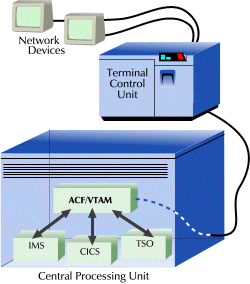
Since the middle 1970's, the data processing community has experienced an unprecedented expansion of its requirements to provide generalized computing facilities to the professional community. This expansion has occurred based upon the rapidly declining cost of individual components that make up a standard computer configuration. Most commonly, the central processing unit (CPU) and its ability to execute instructions economically has led the way towards the extension of the automated system into all facets of business.
As the cost of running application systems became less expensive, the systems themselves became the driving force for improvements in the facilities provided by the computing facility. The early use of "cards" gave way to a sequential tape medium. Eventually, the tape medium was replaced by the direct access medium, which resulted in information being readily available for random inquiry.
But, the hardware was not the only evolution taking place. Software systems capable of managing large amounts of batch work were developed. The software systems were also extended to provide generalized facilities for the support of random queries to the data available on the direct access medium. Teleprocessing systems were paired with locally and remotely connected terminals to provide for timely response to operator queries.
The advent of general terminal availability to the computing community gave rise to timesharing systems, as well as, teleprocessing systems. The data processing community began to utilize the terminal provided access for improved productivity within its own ranks. Quickly, the terminal device became general purpose in its use and in its flexibility.
Today, these terminal devices are themselves programmable and can be used for a wide variety of data processing tasks. They are even used (quite commonly) for interconnection to other systems inside and outside the corporate environment that "owns" them.
Terminal devices have continued to evolve and now deliver tremendous flexibility and function to the individual desktop. Communication with host servers and mainframes across a wide variety of network protocols is now more normal than exception.
Each major software component (software subsystem) established its own primary mechanism for accessing the various terminals. Some common subsystems are:
|
There are, of course, many more subsystems within the data processing community. The fact they are not listed here is not intended to question their viability in the marketplace. The term subsystem will be used throughout this document to discuss all software systems that use ACF/VTAM facilities to communicate with terminals.
The subsystems each originally made their choices between four generally accepted methods to communicate with the terminals. The methods are:
|
Each terminal access method had different characteristics and they were often used in combinations by single subsystems (CICS as an example). This combination of terminal access methods did provide the desired results, but required a heavy commitment by the data processing systems community to keep the terminals and their associated access methods providing service.
The EXCP and BTAM approaches were used chronologically first, but their architectural limitations soon necessitated a more generalized approach. TCAM and its associated Message Control Programs became extremely viable for its consolidated terminal control along with its Time Sharing Option (TSO) interface for programmer productivity.
As the new communications protocols and architectures emerged, it became clear that TCAM, as it stood, would not suffice. The introduction of SNA architecture devices (as well as the communication protocols implied) required review of the whole terminal access method approach. This reorientation occurred with the full introduction of ACF/VTAM as a terminal access method capable of supporting the newer type devices as well as the older asynchronous (ASYNC) and binary synchronous (BI-SYNC) devices.
ACF/VTAM also introduced concepts necessary for the computing facility to share or network terminals between subsystems (like CICS, IMS, and TSO). This concept was also extended to include multiple CPUs (DOMAINs) and multiple networks (accessed via SNI gateway concepts). A large portion of the traditional terminal access method's responsibilities became the job of the terminal network hardware itself. The 370x telecommunications unit began polling BI-SYNC devices (the Network Control Program (NCP) accomplished this in the 3705 and its successors (3725, 3745, etc.)
The evolution of the terminal access methods was motivated by multiple factors.
As a result of these factors, the computing facility has extended into offices and work locations relatively quickly.
The following figure is a simple pictorial representation of two 3270 type terminals remotely connected to a CPU offering CICS, TSO, and IMS. ACF/VTAM has enabled either terminal and its associated user to be logically connected to any of the applications (TSO, CICS, or IMS) available in the host. [We use the graphical representation of a basic personal computer (PC) to represent a generic terminal device. This includes any of a variety of actual hardware terminals, Personal Computers with suitably equipped 3270 connections (LANs, emulator boards, etc.) and any other appropriate 3270 work alike (session managers, etc.). ]

|
To summarize, the increased availability of relatively inexpensive computing facilities has led to a large increase in the number of terminals connected to the computing system.
Various terminal access facilities were and are being developed to respond to the need for easier and more consistent end user terminal interaction with the computing facility. The introduction of the ACF/VTAM Application Program Interface has enabled the major subsystems to utilize a standard terminal interface with which to deal with multiple terminal types.
Flexibility, usability, and productivity are of primary concern. These issues have remained throughout the entire evolution of the information processing environment. The development of Local Area Networks (LANs) and their corresponding access routines (TCP/IP, token ring, Ethernet, etc.) with associated emulation routines has only emphasized the need for providing consistent presentation to the terminal user.